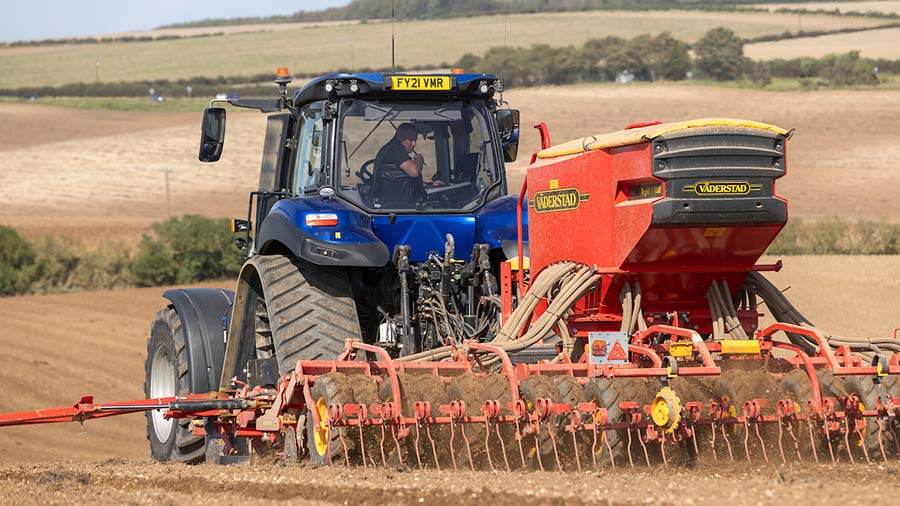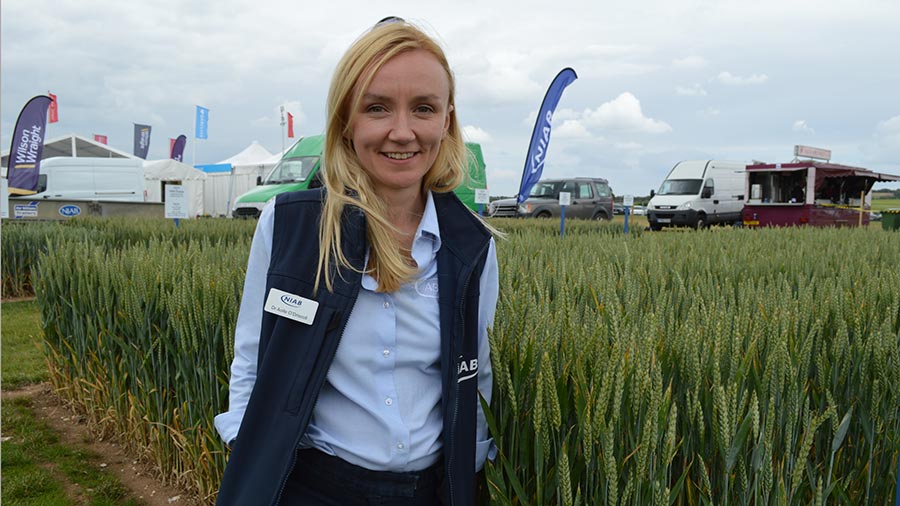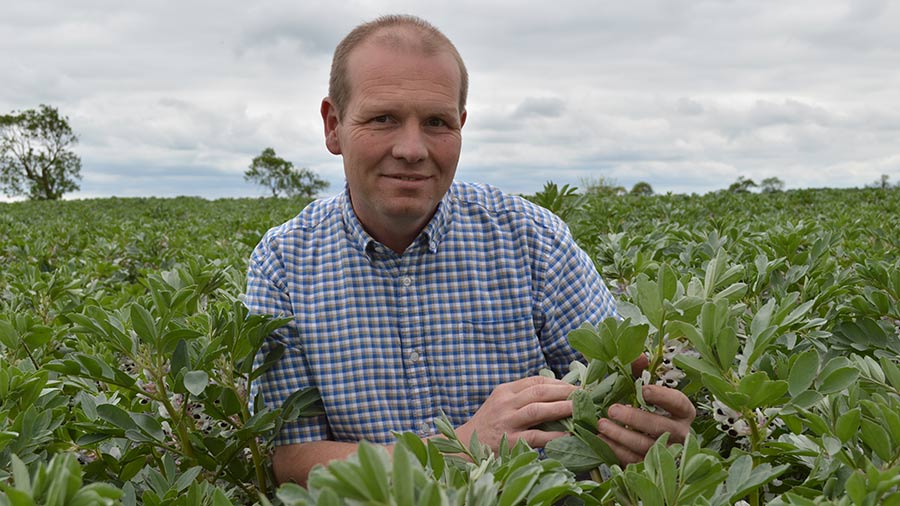Why wheat blends outperform individual varieties
 © Gary Naylor Photography
© Gary Naylor Photography A blend of four winter wheat varieties can help increase yields and allow growers to cut back on fungicides costs as it helps to slow down disease cycling through the crop
Four milling varieties blended together gave a higher yield than any of the individual varieties in 2022 and 2023 trials overseen by Dr Aoife O’Driscoll, senior specialist in plant pathology at crop consultant Niab.
“Growers were asking whether blends can increase yields or allow them to cut fungicide use. Well, they can do both,” she says.
See also: Wheat blends prove simple way to boost average yields
Milling mix
When treated with a standard fungicide regime, the four milling varieties – Skyfall, Crusoe, Illustrious and Zyatt – gave individual yields ranging from 8.8t/ha to 10.75t/ha at 2022 harvest, while a four-way blend of the varieties yielded 11.2t/ha.
In 2023, the four varieties separately reached between 8.8t/ha and 10.8t/ha, while the blend again yielded 11.2t/ha.
There was a disease dilution effect seen in the trial, with septoria spores spread more evenly through the crops. More susceptible varieties saw less disease and more resistant varieties had small levels of disease.
“The blend is better or as good as the best variety and this could lead to some small cuts in fungicide use,” says Aoife.
Feed blends
She points out that in a Champion-Dawsum feed wheat blend, the more septoria-resistant Champion did see some disease, while Dawsum, which has a lower septoria resistance score, was less infected than expected.
Champion scores 8.1 and Dawsum 6.4 for septoria resistance on a 1-9 scale where 9 shows good resistance and 1 is the most susceptible.
The four milling varieties in the trial had a small range of septoria resistance scores, from Skyfall at 5.4 to Crusoe at 6.2.
The four milling varieties tended to develop together, with 75% of the crop showing flag leaf emergence on 15 May, compared with a range of 67-82% for the four varieties grown separately. This suggests that the timing of fungicides is not such a big issue when using blends.
Millers’ views
One concern about using blends, especially breadmaking varieties, is the acceptance by millers. They buy based on variety and know how to deal a variety if it falls short on, say, protein. But dealing with a blend could prove to be more problematic.
However, Aoife points out that 18% of the milling wheat area in France is down to blends, which shows that this trend is taking off in a big way for French growers. She adds that many English growers were putting 5-10% of their wheat area into blends.
In addition, from a yield point of view, Scottish grower Gordon Rennie was hitting world record yields in 1994 using blends of winter wheat and winter barleys.

Aoife O’Driscoll © MAG/David Jones
Nature-friendly farming
South Cambridgeshire grower Martin Lines is cutting back on fungicide use and is seeing better profits, as he has improved his soils, made crop rotations more diverse and introduced nature-friendly farming.
He is achieving good first winter wheat yields of 10-11t/ha and second wheats of 8-9t/ha on his heavy Cambridgeshire clays, and is making more money, as inputs are cut back.
A move to direct drilling has reduced his fuel use by 65%, he has applied no insecticides for nine years, and he is also cutting back on herbicides and fungicides.
“We are seeing better crops from better soils, and by adding nature back to farming, we are achieving better profits,” says Martin.
He is looking to build fertility in his soils, helped by having been in stewardship schemes for the past 20 years. He says applying more fertiliser often encourages more disease.
“If we put on more fertiliser to get 0.2t/ha extra yield, we were having to put on another fungicide,” he says.

Martin Lines © MAG/David Jones
Fungicide cuts
He has cut back winter wheat fungicides use to just T1s and T2s, with no T0s, and is flexible when he sprays, pushing back timings if there is no disease threat.
He says if his plants get stressed, it’s not nitrogen they need, but micronutrients.
He has halved his winter barley fungicide sprays from two to one, his winter beans only get one fungicide, and his in-field wildflower strips have helped him cut out insecticides. He is also using fewer slug pellets.
“We are not chasing yield, we are chasing margin. We are putting nature at the heart of the business and nature is free,” adds Martin.
He farms 165ha at Papley Grove Farm, with other land rented or contracted.
In some areas of the farm, using Countryside Stewardship and the Sustainable Farming Incentive (SFI), he is earning more than with the old Basic Payment Scheme.
Direct drilling
Dr Henry Creissen, a research fellow in crop protection at Scotland’s Rural College, has looked at how Scottish farms are reacting to the SFI.
He points out that a move to direct drilling, which could be a part of the SFI for next year, can lead to more disease pressure.
His work showed that where winter barley was established by direct-drilling into chopped straw, there were more trash-borne diseases such as rhynchosporium, and this often necessitated an extra fungicide compared with a plough-based system.
“On sites with reduced tillage, there was more of a response to fungicide use,” he says, adding that winter barley crops established using reduced tillage in Scotland often needed a third fungicide, instead of the usual two-spray regime.
Looking at spring barley grown in a regenerative system, he says the best programmes – and usually the most profitable ones – did use some fungicides.
Carbon counting
The use of fungicides in arable farming could actually reduce overall carbon emission, says Tamara Fitters, research consultant at crop consultant Adas.
The use of fungicides in an Adas trial showed that winter wheat yields increased to 10.20t/ha from 8.42t/ha.
This use of fungicides increased carbon emissions by 59kg carbon dioxide equivalent/t, but the need for more wheat land to make up for that yield decline would have led to emissions of 277kg.
Considering fungicide use achieved a yield increase of 21%, if no fungicides were used across the whole UK, there would have to be a big increase in the wheat area of just over 1.8m hectares to make up for this loss in yield.
Tamara pointed out that 70% of greenhouse gas emissions from arable farming is associated with nitrogen fertiliser, whether from manufacturing, spreading or emissions in the field.
Farms with lower greenhouse gases emissions were associated with lower nitrogen use.
Interestingly, farms with lower greenhouse gas emissions tended to show higher yields due to better efficacy of nitrogen use, less intensive cultivations, less grain drying, and less manures and phosphorus and potassium fertilisers applied.
In addition, she pointed out that a one point rise in septoria resistance can cut yield loss by 0.31t/ha, so better plant genetics can lead to less emissions.
British Crop Production Council’s (BCPC) diseases review 2023
All the speakers were attending the British Crop Production Council’s (BCPC) diseases review 2023 meeting on “Disease control – Balancing food security and environmental responsibility”, held on 17 October 2023 at Niab’s Park Farm facility. BCPC is part of the Niab Group.

